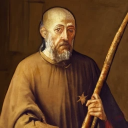St. Niklaus
This article is incomplete because it is pending further input from participants, or it is a work-in-progress by one author. Please comment on this article's talk page to share your input, comments and questions. Note: To contribute to this article, you may need to seek help from the author(s) of this page. |
St. Niklaus | |
|---|---|
| Born | 1572-1569 BL Berushia, Ledonian Empire |
| Died | 1308 BL (aged 261-264) Holy River |
| Resting place | Holy Temple of Saletrism |
| Known for | Founder of Saletrism |
| Spouse(s) | Aphrodisia (first wife)
Medea (concubine) Astraea (concubine) Augusta (concubine Lucina (concubine) |
| Children | Idesta (with Medea)
Florentius (with Medea) Scholastica (with Medea) Jacinthus (with Aphrodisia) Timæus (with Astraea) Nereida (with Astraea) Alexandrus (with Augusta) Nicholaa (with Lucina) Augustus (with Lucina) |
| Parents |
|
St. Niklaus (possibly Klaudius) was a Ledonian priest, religious author, and the founder of Saletrism. According to holy book of the religion, he was the link between the Gods and man, and his teachings are recorded in Niklaus' Laws of Holiness and Saletrism. He was also the first head of the religion.
According to Niklaus' Laws of Holiness and Saletrism, St. Niklaus was born between 1572 and 1569 BL. He was abandoned at a young age, and after floating down a river for a few days, was adopted by Claudia IV and Æsop. He is said to have been given signs by the Gods when he retreated to a mountain, after growing concern for the practices of Voruchuism. Afterwards, he started preaching about the Gods and their Holy Word, until his execution in in 1526, at the age of 43, for spreading, according to Voruchuist priests of the time, lies and slander.
The priest was revived in 1523, after his remains coalesced in the Holy River (also sometimes refered to as the Saletry River); from there, the priest continued to spread Saletrism across Ledonia. During his lifespan, Niklaus had several concubines from across the Empire, through which he has numerous descendants. The priest was given a promise by the Gods that he would be the father of a holy empire, and when Niklaus died in 1308, this promise was given to Priest Augustus, one of his younger children.
Sources of biographical info
Niklaus' Laws of Holiness and Saletrism
Niklaus' Laws of Holiness and Saletrism is the central religious text of Saletrism. Saletrists believe that the laws and teachings in the book were given by the Gods to the saint. The text also describes the frequent oppression faced by adherents to the religion early on.
The Laws of Holiness and Saletrism, however, does not provide much assistance in biographical information about St. Niklaus. Various points in the text contradict official documents at the time, and the priest is never referred to as St. Niklaus in the book; he refers to himself as Klaudius, which is the official listed name by the government. Almost none of the saint's family is detailed in the text either, continuing to add to the controversy regarding his identity.
Official documents
Important sources about the life of St. Niklaus can be found in official documents that were recorded by the government of the province of Berushia. These include birth and death certificates, family info, and his time as a priest.
The earliest written document was his birth certificate, which detailed where and when he was born, who his parents were, and what his predicted job would be. Supposedly, his parents were Paulus and Prudentia, two prominent members of a merchant family. He also allegedly was born in 1572 BL, which contradicts Niklaus' Laws of Holiness and Saletrism, which states that he was born in 1569.
The overwhelming majority of sources, including the Laws of Holiness and Saletrism, agree that he was abandoned at an unspecified age. He was adopted by Claudia IV and Æsop, two lower-class citizens. Another document was written, which listed his parents as the two mentioned. However, it stated that his name was Klaudius, after his mother, which contradicts the name by which he is known by.
